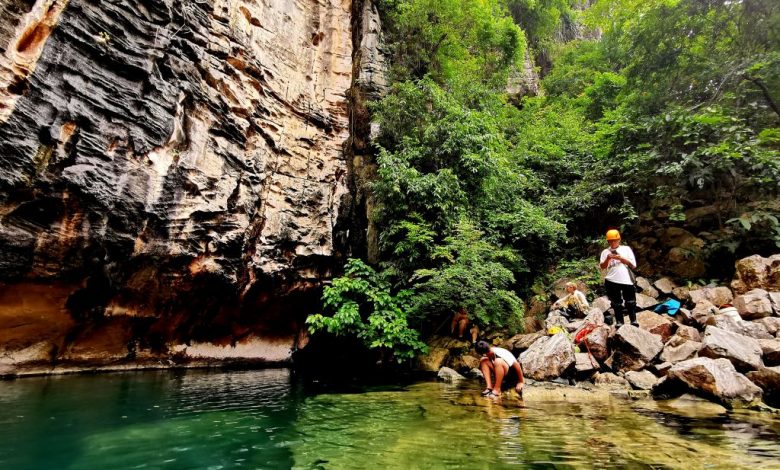Have You Been to Gua Air in Simpang Pulai?


By Vivien Lian


Gua Air is only one of the caves of Gunung Lanno or Lanno Mountain in Kinta Valley, which has a total of 36 caves, namely, Gua Di Tepi Tasik, Gua Portal, Gua Gatsch, Gua Kintaly, Gua Panorama, Gua Polai Atas, Gua Puncak, Gua Air, Gua Kupu Kupu, Gua Kala Jengking, Gua Anjing Anjing, Gua Selari, Gua Pulau, Gua Batu Nesan, Gua Lanno, Gua Anjung, Gua Monophyllaea, Gua Tanah Merah, Gua Batu Pencuri, Gua Cicak, Gua Keelback, Gua Ikan, Gua Piyachat, Gua Thai Atas, Gua Telur Cicak, Gua Gereja Hujan, Gua Kera Mati, Gua Thai Monk, Gua Kandang Babi, Gua Kong Fook Ngam, Gua Gigi Gergaji, Gua Sri Sava Subramaniar, Gua Angin, Gua Anjing Mati, Gua Akar and Gua Ngia.




The longest caves in Gunung Lanno, in ascending order are Gua Kong Fook Ngam, Gua Lanno, Gua Selari and Gua Puncak. Kong Fook Ngam Cave Temple, which was founded in 1884, is only one out of 36 caves known to most locals. According to Vicinity Perak – Ipoh’s Golden Mountain – Volume 2 Issue 9, September 2006, Gunung Lanno was mined continuously until the mid-1920s, employing more than 300 men through until 1920. It gave Charles Alma Baker, Kinta Land Office Contract Surveyor from 1892 to 1897, an annual income of $40,000 to $50,000.
Is limestone obtained only through limestone hill blasting?
In July 2015, The Star had an interview with Ramli Mohd Osman, a senior research officer at the Mineral Research Centre, an agency under the Minerals and Geoscience Department. According to Ramli, blasting limestone hills to get materials for making cement is unnecessary. There is a whole lot more limestone deposits just below the ground in many old mining areas in Perak. In fact, the cache of limestone in these places is six times more than what can be obtained from the hills. He says three companies which are already quarrying for limestone in old mining land in Perak are Tasek Corp in Kinta, Hume Cement in Kampar and Lhoist in Batang Padang, shows it to be practical and economical. From surveys with the companies, he found that the additional cost because of assessments to locate the limestone deposit, depth and quality is only marginally higher than quarrying limestone hills. “That is the cost we have to pay if we want to preserve limestone hills,” he says. Extracting subsurface stores of limestone is one way to stop the destruction of majestic limestone hills, which threatens plans to set up the Kinta Valley Geopark. But even as former Perak Mentri Besar Dato’ Seri DiRaja Dr Zambry Abdul Kadir was announcing grand plans for the geopark, the karsts there continued to be blasted. Despite having 36 caves, Gunung Lanno is not listed in the list of geoparks to be preserved and promoted for tourism. Sounds familiar? Things still remained the same.


Gua Air, photo by Maggie Chan


Do all quarries abide by Perak Quarry Rules 1992?


Presently, there are about 70 quarries operating around Simpang Pulai. Most of them process limestone and supply them to a number of factories within the state and abroad. The local market, however, is small. They depend much on the export market, and India is the main export destination. Limestone is a non-renewable resource but according to a report by MNS Perak branch, it is estimated that there are 1302 limestone hills and 1722 caves in Malaysia. Perak has 80 limestone hills with 192 caves. The highest number of limestone hills and caves in Perak is in the Kinta Valley that has 45 limestone hills and 135 caves. Therefore, limestone hills in Perak are indeed a major source of income, considering the commercial viability of it – toothpaste, in cereals, in cosmetics, plastic items, livestock feed, white pigment or fillers in food, paint, paper, plastic and rubber; building materials, marble, tombstone and the list goes on. Limestone exploitation is necessary but in the right way aforementioned. The monitoring process is important and whether the quarries abide by Perak Quarry Rules 1992.




You can see what’s at the bottom in Gua Air


Gua Air


Kayaking in Gua Air but a revisit few days ago shown that the water is not clear anymore, we can’t see what’s at the bottom and the blasting is a lot more closer to Gua Air. (from left to right- Lee, Maggie and me) Photo by Ching Boon Tat
In the case of Gua Air, it is an out of the world experience for one who has visited the place. Water is crystal clear; you can see what’s at the bottom and tourists would flock to Simpang Pulai just to experience kayaking in the cave. Ironically, the blast has taken place, hope the government would step in before Gua Air turns into Gua Tak Ada Air.


